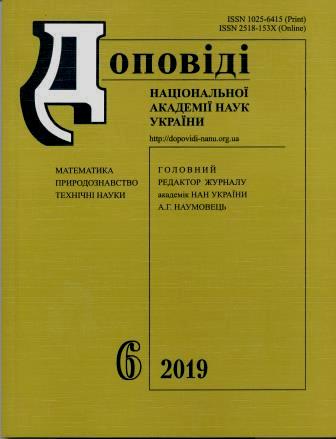Про можливість блокування центрів специфічного впізнавання ДНК молекулами пероксиду водню під час іонної терапії
DOI:
https://doi.org/10.15407/dopovidi2019.06.082Ключові слова:
нуклеїнові основи ДНК, пероксид водню, ракова терапіяАнотація
Іонна терапія є одним з найефективніших методів лікування ракових захворювань. Але до цього часу механізм дії важких іонів на ракові клітини не визначений. Вивчення процесів фрагментації води під час іонної терапії показує, що серед великої кількості різних фрагментів у середовищі клітини утворюється значна концентрація молекул пероксиду водню (H2O2). У роботі наведено результати дослідження конкурентної взаємодії молекул Н2О2 та Н2О із центрами специфічного розпізнавання ДНК. Енергії взаємодії комплексів, що складаються з нуклеїнових основ (аденін, тимін, гуанін і цитозин) разом з молекулами пероксиду водню і води, обчислені із застосуванням методу атом-атомних потенціальних функцій і теорії функціонала густини. Знайдено атомні групи нуклеїнових основ, які є більш енергетично вигідними для зв’язування з молекулами пероксиду водню, ніж з молекулами води. Утворення таких комплексів може блокувати процес реплікації ДНК на різних етапах і може бути одним з механізмів дії високоенергетичних іонів на ракові клітини.
Завантаження
Посилання
Bragg, W. H. & Kleeman, R. (1904). LXXIV. On the ionization curves of radium. London, Edinburgh, Dublin. Philos. Mag. J. Sci., 48, No. 8, pp. 726-38. doi: https://doi.org/10.1080/14786440409463246
Solov’yov, A. V., Surdutovich, E., Scifoni, E., Mishustin, I. & Greiner, W. (2009). Physics of ion beam cancer therapy: a multiscale approach. Phys. Rev. E, Stat. Nonlin. Soft Matter. Phys., 79, No. 1, 011909. doi: https://doi.org/10.1103/PhysRevE.79.011909
Krämer, M. & Durante, M. (2010). Ion beam transport calculations and treatment plans in particle therapy. Eur. Phys. J. D, 60, No. 1, pp. 195-202. doi: https://doi.org/10.1140/epjd/e2010-00077-8
Boscolo, D., Krämer, M., Durante, M., Fuss, M. C. & Scifoni, E. (2018). TRAX-CHEM: A pre-chemical and chemical stage extension of the particle track structure code TRAX in water targets. Chem. Phys. Lett., 698, pp. 11-18. doi: https://doi.org/10.1016/j.cplett.2018.02.051
Piatnytskyi, D. V., Zdorevskyi, O. O., Perepelytsya, S. M. & Volkov, S. N. (2015). Understanding the mechanism of DNA deactivation in ion therapy of cancer cells: hydrogen peroxide action. Eur. Phys. J. D, 69, No. 11, pp. 255. doi: https://doi.org/10.1140/epjd/e2015-60210-9
Zdorevskyi, O. & Volkov, S. N. (2018). Possible scenarios of DNA double-helix unzipping process in singlemolecule manipulation experiments. Eur. Biophys. J., 47, No. 8, pp. 917-24. doi: https://doi.org/10.1007/s00249-018-1313-3
Zhurkin, V. B., Poltev, V. I. & Florent’ev, V. L. (1980). Atom-atomic potential functions for conformational calculations of nucleic acids. Mol. Biol. (Mosk.), 14, No. 5, pp. 1116-30.
Poltev, V. I. & Shulyupina, N. V. (1986). Simulation of interactions between nucleic acid bases by refined atom-atom potential functions. J. Biomol. Struct. Dyn., 3, No. 4, pp. 739-65. doi: https://doi.org/10.1080/07391102.1986.10508459
Moin, S. T., Hofer, T. S., Randolf, B. R. & Rode, B. M. (2012). An ab initio quantum mechanical charge field molecular dynamics simulation of hydrogen peroxide in water. Comput. Theor. Chem., 980, pp. 15-22. doi: https://doi.org/10.1016/j.comptc.2011.11.006
Hingerty, B. E., Ritchie, R. H., Ferrell, T. L. & Turner, J. E. (1985). Dielectric effects in biopolymers: The theory of ionic saturation revisited. Biopolymers, 24, No. 3, pp. 427-439. doi: https://doi.org/10.1002/bip.360240302
Frisch, M. J., Trucks, G. W., Schlegel, H. B., Scuseria, G. E., Robb, M. A., Cheeseman, J. R., Montgomery, J. A., Vreven, T., Kudin, K. N., Burant, J. C., Millam, J. M., Iyengar, S. S., Tomasi, J., Barone, V., Mennucci, B., Cossi, M., Scalmani, G., Rega, N., Petersson, G. A., Nakatsuji, H., Hada, M., Ehara, M., Toyota, K., Fukuda, R., Hasegawa, J., Ishida, M., Nakajima, T., Honda, Y., Kitao, O., Nakai, H., Klene, M., Li, X., Knox, J. E., Hratchian, H. P., Cross, J. B., Bakken, V., Adamo, C., Jaramillo, J., Gomperts, R., Stratmann, R. E., Yazyev, O., Austin, A. J., Cammi, R., Pomelli, C., Ochterski, J. W., Ayala, P. Y., Morokuma, K., Voth, G. A., Salvador, P., Dannenberg, J. J., Zakrzewski, V. G., Dapprich, S., Daniels, A.D., Strain, M. C., Farkas, O., Malick, D. K., Rabuck, A. D., Raghavachari, K., Foresman, J. B., Ortiz, J. V., Cui, Q., Baboul, A. G., Clifford, S., Cioslowski, J., Stefanov, B. B., Liu, G., Liashenko, A., Piskorz, P., Komaromi, I., Martin, R. L., Fox, D. J., Keith, T., Laham, A., Peng, C. Y., Nanayakkara, A., Challacombe, M., Gill, P., Johnson, B., Chen, W., Wong, M. W., Gonzalez, C. & Pople, J. A. (2004). Gaussian 03, Revision C. 02. Wallingford, CT.
Kryachko, E. S. & Volkov, S. N. (2001). Preopening of the DNA base pairs. Int. J. Quantum Chem, 82, No. 4, pp. 193-204. doi: https://doi.org/10.1002/qua.1040
Giudice, E., Várnai, P. & Lavery, R. (2003). Base pair opening within B-DNA: free energy pathways for GC and AT pairs from umbrella sampling simulations. Nucleic Acids Res., 31, No. 5, pp. 1434-43. doi: https://doi.org/10.1093/nar/gkg239
Dobado, J. A. & Molina, J. (1999). Adenine-hydrogen peroxide system: DFT and MP2 investigation. J. Phys. Chem. A, 103, No. 24, pp. 4755-61. doi: https://doi.org/10.1021/jp990671n
Seeman, N. C., Rosenberg, J. M. & Rich, A. (1976). Sequence-specific recognition of double helical nucleic acids by proteins. Proc. Natl. Acad. Sci. USA, 73, No. 3, pp. 804-808. doi: https://doi.org/10.1073/pnas.73.3.804
##submission.downloads##
Опубліковано
Як цитувати
Номер
Розділ
Ліцензія
Авторське право (c) 2024 Доповіді Національної академії наук України

Ця робота ліцензується відповідно до Creative Commons Attribution-NonCommercial 4.0 International License.




